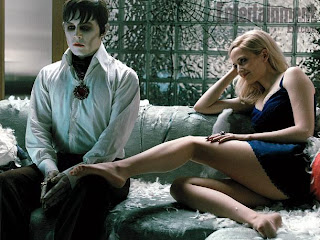As Barnabas Collins in Tim Burton’s
Dark Shadows, Johnny Depp comports himself like a Gothic popinjay. He carries himself proudly erect, and speaks with orotund, self-dramatizing verbosity and sweeping gesture, whether anyone else is around to hear him or not. The performance is a near-tour de force of comic, cosmically wounded dignity.
Being a vampire, he must occasionally feast on the blood of the living, but he does so reluctantly, first offering his victims polite regrets. His great wish, other than to be reunited with his lost love Josette, is to restore his family’s Maine fish cannery. He’s a bit of a pussycat, as undead revenants go.
It’s hard to say to whom this
Dark Shadows is being marketed. The film is a parody, a pretty broad one, of the Gothic-horror soap opera (ABC, 1966-1971) on which it’s based. Created by Dan Curtis and writer Art Wallace, the show began as tempestuous bosom-heaving romance, perhaps in the vein of Barbara Cartland, but faced with sinking ratings, the writers began to experiment with ghosts and other supernatural elements about six months in, and eventually they threw a Hail Mary in the form of Barnabas, a forlorn vampire played by an obscure Canadian stage actor named Jonathan Frid.
He was a hit, and so the show threw caution to the wind—witches, werewolves and any other gruesome menace became fair game. Two movie spin-offs,
House of Dark Shadows (1970) and
Night of Dark Shadows (1971) were produced, along with dozens of tie-in novels, comic books, toys, puzzles, etc. I was too much of a wussy, at six or seven, to watch the show for more than a few wide-eyed minutes during its original run, but I got hooked on it in junior high, when it ran in syndication. Even by soap standards, it seemed to have a high incidence of blown lines, crew members caught on camera, actors struggling not to crack up, but somehow this didn’t defeat the show’s spooky yet oddly bracing atmosphere.
The Burton film’s script, credited to Seth Grahame-Smith of
Abraham Lincoln, Vampire Hunter, takes scraps of plot from the old show and stitches them together, but there’s almost no serious attempt at spookiness. A friend of mine said that the ads make the movie look like a sketch from
The Carol Burnett Show.
Many fans of the original series are likely to be disappointed—if not outraged—by such an approach, while non-fans and younger viewers are unlikely to be too interested in a comedic version of an old TV show that they may never have heard of in the first place. Overall, the film seems poised to be vaporized by
The Avengers’ second weekend like a vampire by a ray of sunlight.
A small pity if so, because while
Dark Shadows is hardly high art, it’s sort of an endearing trifle. As always with Burton, it’s a beautiful movie to look at, with a whimsical, Edward-Gorey-ish look (the production designer is Rick Hienrichs) and a ridiculously attractive cast.
My friend’s take on the movie’s attitude was about right—it plays like a string of
Carol Burnett sketches, with a bit more polish to the jokes and a lot more polish to the production. The target of the parody isn’t Gothic melodrama but ‘70s kitsch culture, with the 18th-Century sensibilities of the resurrected Barnabas bounced off of hippies and television and lava lamps and fast food signage and Steve Miller’s “The Joker” (of which Barnabas approves—unsurprisingly, since as played by Depp he most certainly speaks of the Pompatus of Love).
Depp is a hoot, but he isn’t alone. The high-ticket cast is fine form: Michelle Pfeiffer in Joan Bennett’s old role of matriarch Elizabeth Collins Stoddard, Chloe Moretz as wild child Carolyn Stoddard, the waiflike Australian Bella Heathcote as Victoria Winters, Jackie Earle Haley as drunken handyman Willie Loomis, and the always-excellent Helena Bonham Carter as the shady shrink Dr. Hoffman. Alice Cooper and Christopher Lee turn up in guest roles.
The movie is close to stolen, however, by the French actress Eva Green as Angelique Bouchard, the witch who cursed Barnabas with vampirism when he didn’t return her love, and who’s still around in the 20th Century, running a rival fish cannery and looking intolerably chic. Green (she played Vesper Lynd in the 2006 Bond film
Casino Royale) makes Angelique’s spite a lively aphrodisiac; she has a crazy-eyed smile that’s both alluring and terrifying, and her skin’s tendency, in moments of stress, to crack like the shell of a hard-boiled egg is rather captivating, too.
Burton and Grahame-Smith probably try to touch too many bases from the series—the movie is cluttered, and it goes on at least twenty minutes too long. But overall, it’s a goofy pleasure. Like the old show, it’s an enjoyable waste of time. Unlike the old show, it can be experienced in one sitting, and its laughs are intentional.



























